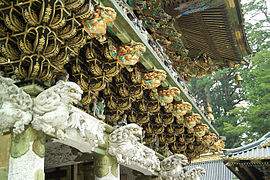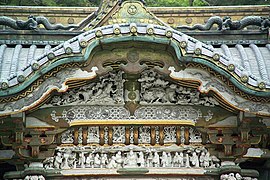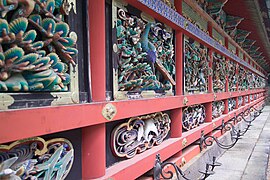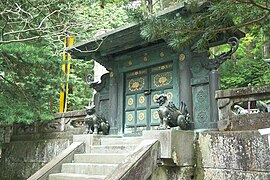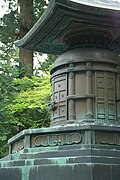Nikkō Tōshō-gū
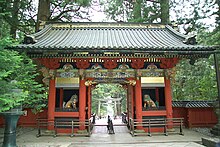
Nikkō Tōshō-gū ( Japanese 日光 東 照 宮 ) is a Shintō shrine in the city of Nikkō in Tochigi Prefecture in Japan . He is Tokugawa Ieyasu , founder of the Tokugawa dynasty dedicated, and was built in 1617 when Ieyasu's son Hidetada Shogun was. It was expanded by the third Shogun, Tokugawa Iemitsu , including the main building of today's shrine. In 1999 it was named a World Heritage Site by UNESCO, along with other shrines and temples in Nikko . Ieyasu is venerated in the Nikkō Tōshō-gū, and his remains are also buried here. The shrine is the most famous of all the Tōshō-gū in Japan.
During the Edo period , the Tokugawa Shogunate hosted state processions from Edo to Nikkō Tōshō-gū. In the annual spring festival (on May 17th and 18th, until 1951 on June 1st and 2nd) and autumn festival (on October 17th) these events are recreated and are known as the procession of the thousand warriors ( Sennin-gyōretsu ).
Eight buildings of the shrine and two swords, which are the property of the shrine, are national treasures of Japan : main hall ( honden ) including prayer hall ( haiden ) and connecting corridor ( ishi-no-ma ), the main gate Yōmei-mon ( 陽明 門 , "gate of sunlight “) Built in 1636, the Chinese gate ( karamon ), two splendid east-west walls and two tours. 34 other buildings and other objects are important national cultural assets .
Hundreds of stone steps accompany by a Japanese cedar forest upward to the grave Ieyasus in the inner district ( Okunoin ) of the shrine. A torii at the top of the tip has decorations that are ascribed to Tennō Go-Mizunoo . The remains of Ieyasu are kept in a bronze urn, outdoors and in its own smaller shrine, the Okusha Hōtō ( 奥 社 宝塔 ). This was originally a wooden pagoda built in 1622, then replaced by a new stone model in 1641 and rebuilt from bronze after an earthquake in 1683, with special constructions to prevent the ingress of water.
Particularly impressive are the the daimyo Matsudaira Masatsuna (he had served under the first three Tokugawa shoguns) over 300 years ago for the 32nd anniversary of the death of Ieyasu in a period of over 20 years planted cedars on the way to Nikko, of which there are currently still several thousand there.
The famous carving of the three monkeys on the facade of the sacred horse stable
Remarks
- ↑ Tōshō Daigongen is the posthumously awarded Shinto honorary title to Ieyasu.
Web links
- Official website of the Nikkō Tōshō-gū (Japanese)
- Information offered by the city of Nikkō ( Memento of March 3, 2006 in the Internet Archive ) (English)
- Columbia University website on Nikkō Tōshō-gū (English)
- Religion in Japan: Tōshōgū (dt.)
- 日光 祭礼 絵 巻 , several emaki depicting the annual procession at the shrine, owned by the Kokugakuin Shinto Museum (Japanese)
Coordinates: 36 ° 45 ′ 29 " N , 139 ° 35 ′ 55.9" E


